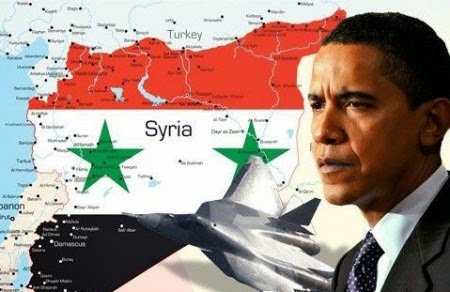 |
| Image |
Brandon Turbeville
Activist Post
In what is more proof that the NATO operation against Syrian President Bashar al-Assad is merely Libya 2.0, the Obama administration is now stating that it is open to the possibility of establishing a “no-fly zone” over Syria.
The statements, made by both Secretary of Defense Chuck Hagel and General Martin E. Dempsey, are supposed to hinge upon an agreement with Turkey, that is itself calling for a “buffer zone,” one of the wishes of NATO since the very beginning of the Syrian crisis.
According to the New York Times, Hagel stated that “We’ve discussed all these possibilities and will continue to talk about what the Turks believe they will require.”
Dempsey added that “a buffer zone might at some point become a possibility” although he also stated that it should not be considered imminent.
A “buffer zone” and/or a “no-fly zone,” of course, is tantamount to war and an open military assault against the sovereign secular government of Syria since the implementation of such a zone would require airstrikes against Assad’s air defense systems.
Turkey is now whining and groaning over an influx of Syrian refugees as a result of a humanitarian crisis that it helped create with its support and facilitation of Islamic fundamentalist death squad forces funded by the West and allowed to travel into Syria through Turkey’s borders. The most recent influx of refugees came from the city of Kobani, where ISIS fighters were herded by American airstrikes for the purposes of reinforcing the fighters already battling Kurdish and Syrian forces there.
Keep in mind that with the terrorists evacuating Deir al-Zor, cities and towns such as Kobani (Ayn El Arab) have seen a dramatic rise in the presence of IS fighters. In short, IS may have reduced the amount of fighters in Deir al-Zor but it reinforced its positions at Ayn El Arab, a smaller town but one located on the Turkish border. Significantly, the Turkish border has facilitated tens of thousands of death squad fighters in their access to Syria over the last four years making it a main artery for the influx of Western-backed foreign jihadis into Syria.
The Huffington Post reported the situation in Ayn El Arab by recording the statement of a Syrian Kurd who had fled into Turkey with his family to escape IS. The report is revealing as to how the situation in Ayn El Arab disintegrated after the bombing of Deir al-Zor and the “escape” of terrorists from that city and region. The article reads,
“Because of the bombing in Raqqa, Islamic State has taken all of their weapons and brought them here. There are more and more Islamic State fighters in the last two days, they have brought all their forces here,” said Ahmed Hassan, 60, a Syrian Kurd who fled to Turkey with his family.
“They have heavy weapons. We are running away from them. YPG haven’t got heavy weapons. That’s why we need help,” he said, referring to the main Kurdish armed group.
Thus, the new assault on Ayn El Arab might very well be an attempt to re-secure and reopen the Turkish/Syrian border so as to allow even greater numbers of IS fighters and military equipment to flood into Syria.
 In order for NATO forces to effectively remove Assad, who has proven a major hurdle for the Anglo-American establishment in its efforts to overthrow him and further their geopolitical goals of weakening Russia’s strategic position and influence, NATO forces absolutely must eliminate his air defenses. However, even the United States has admitted that doing so is risky business.
In order for NATO forces to effectively remove Assad, who has proven a major hurdle for the Anglo-American establishment in its efforts to overthrow him and further their geopolitical goals of weakening Russia’s strategic position and influence, NATO forces absolutely must eliminate his air defenses. However, even the United States has admitted that doing so is risky business.
For that reason, the West used its ISIS proxy forces to destroy the Taqba air base in eastern Syria so as to open up half of the country to US military assault.
For those who may not see the pattern – while the United States and NATO deliberated engaging in targeted airstrikes in Syria and the Syrian government subsequently states its opposition to those attacks and its intentions to shoot down the planes delivering those strikes if they did not coordinate with the Syrian government, death squad have effectively eliminated the air defense capability of the Syrian government in the east of the country.
After all, the Pentagon even stated that one of the biggest threats to an airstrike operation in Syria is the Syrian government’s air defenses. Thanks to ISIS, those air defenses no longer exist in the east of Syria.
This was the end game of the ISIS battle to take over Taqba from the start – eliminate air defenses so that the NATO powers can launch airstrikes against the Syrian military and thus freeing up a launching pad for the terrorists to conduct attacks even deeper into Syria.
Even the airstrikes taking place currently under the guise of eliminating ISIS have a much darker motive. Although it is true that ISIS/ “moderate death squads” had seized control over the oil refineries in Eastern Syria and were using them for their own strategic purposes (with the help of NATO command), it is also true that, in a large portion of these areas, the SAA (Syrian Arab Army) was poised to retake control.
This is particularly the case in Dayr el Zor, where the SAA had recently launched a major offensive against the death squads causing ISIS fighters trapped by aerial bombardment and escape routes cut off by the SAA. In other words, the death squads were trapped in Dayr el Zor, the city was weeks away from being liberated, and the surrounding areas were set to be reconquered by the SAA. This, of course, would have led directly to the retaking of the oil refineries by the Syrian government. Unfortunately, that opportunity has now been lost as a result of the U.S. airstrikes which destroyed the refinery infrastructure.
It should also be remembered that most of the death squads fled these areas after being given forewarning of a series of imminent American airstrikes, thus causing the civilian casualties to be higher in number than those of the ISIS fighters the strikes were allegedly targeting. Indeed, many of these fighters have appeared in Northern Syria on the Syria/Turkey border reinforcing other death squad battalions in efforts to reopen supply lines from Turkey.
Similar situations are found in the other locations mentioned as targets of U.S. airstrikes such as al-Hasakah where the SAA had made significant gains alongside Kurdish forces.
Thus, as SAA forces moved in to retake control of the oil refineries managed by terrorists funded by Western powers, the United States initiated airstrikes just in the nick of time to deprive SAA forces of the opportunity to seize some of the oil refinery infrastructure it desperately needs.
It is also important to note that virtually none of the infrastructure being destroyed by the United States airstrikes was built by ISIS. It was built by the Syrian government. The reality of the bombing campaign is that the United States and its allies are destroying important regions of Syria and leaving nothing of real value for the Syrian military to retake after its long-fought battles against ISIS.
Thus, headlines across the world should more accurately read “US Bombs Syrian Oil Refineries To Prevent Assad From Retaking Them.”
Still, one should keep in mind that it is not only the oil refineries which are being targeted but whole neighborhoods filled with civilians. One such neighborhood was the town of Kfar Daryan.
 It also goes some distance in aiding the future creation of a “buffer zone,” in Northern Syria, a wish of NATO since the beginning of the Syrian crisis.With the establishment of this “buffer zone,” a new staging ground will be opened that allows terrorists such as ISIS and others the ability to conduct attacks even deeper inside Syria.
It also goes some distance in aiding the future creation of a “buffer zone,” in Northern Syria, a wish of NATO since the beginning of the Syrian crisis.With the establishment of this “buffer zone,” a new staging ground will be opened that allows terrorists such as ISIS and others the ability to conduct attacks even deeper inside Syria.
Working together with its NATO/GCC allies as well as the ever-present provocateur Israel, the United States is helping to create a buffer zone in the North and East of Syria while continuing to facilitate the opening of a “third front” on the Syrian border with Israel.
Such a strategy was discussed in 2012 by the Brookings Institution in its publication “Assessing Options For Regime Change,” where it stated
An alternative is for diplomatic efforts to focus first on how to end the violence and how to gain humanitarian access, as is being done under Annan’s leadership. This may lead to the creation of safe-havens and humanitarian corridors, which would have to be backed by limited military power. This would, of course, fall short of U.S. goals for Syria and could preserve Asad in power. From that starting point, however, it is possible that a broad coalition with the appropriate international mandate could add further coercive action to its efforts.
[…]
In addition, Israel’s intelligence services have a strong knowledge of Syria, as well as assets within the Syrian regime that could be used to subvert the regime’s power base and press for Asad’s removal. Israel could posture forces on or near the Golan Heights and, in so doing, might divert regime forces from suppressing the opposition. This posture may conjure fears in the Asad regime of a multi-front war, particularly if Turkey is willing to do the same on its border and if the Syrian opposition is being fed a steady diet of arms and training. Such a mobilization could perhaps persuade Syria’s military leadership to oust Asad in order to preserve itself. Advocates argue this additional pressure could tip the balance against Asad inside Syria, if other forces were aligned properly.
At the end of the day, it is important to remember that the U.S. airstrikes and its attempts to create a “buffer zone” inside Syria are nothing more than a farce. The death squads running amok in Syria are themselves entirely creatures of NATO and they remain under NATO’s command. The true enemy of ISIS, Khorasan, and the cannibals of the Levant has always been and continues to be Bashar al-Assad.
For those of us who have tried to warn of and prevent a direct military intervention in Syria, we must now continue to keep the Syrian people in our thoughts and prayers.
But we must also keep the United States in those thoughts and prayers. Like in Libya, for what is being done in our name, we are earning some terrible karmic consequences.
The United States has sown some very bitter seeds in recent years. Unfortunately, there will be a day when we all are forced to reap the bitter harvest.
Recently by Brandon Turbeville:
- Is The US Targeting Oil Refineries To Stop ISIS or Assad?
- Report: Iraqi Official Claims U.S. To Station 13,000 Troops In Iraq
- The Real Reasons For U.S. Airstrikes In Syria – Breaking The Assad Regime
Brandon Turbeville is an author out of Florence, South Carolina. He has a Bachelor’s Degree from Francis Marion University and is the author of six books, Codex Alimentarius — The End of Health Freedom, 7 Real Conspiracies, Five Sense Solutions and Dispatches From a Dissident, volume 1and volume 2, and The Road to Damascus: The Anglo-American Assault on Syria. Turbeville has published over 300 articles dealing on a wide variety of subjects including health, economics, government corruption, and civil liberties. Brandon Turbeville’s podcast Truth on The Tracks can be found every Monday night 9 pm EST at UCYTV. He is available for radio and TV interviews. Please contact activistpost (at) gmail.com.


Be the first to comment on "Libya 2.0? US Says ‘No-Fly Zone’ Over Syria A Possibility"